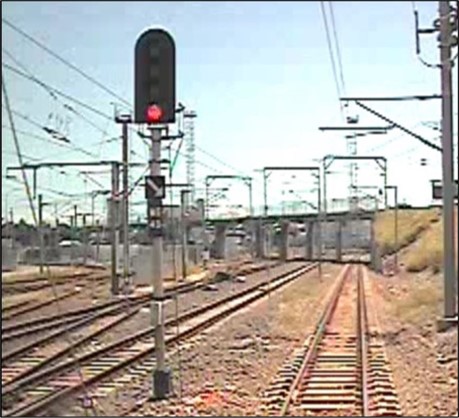
|
Key points:
|
An emergency ‘STOP’ command issued by a network control officer avoided the potential for collision between two Brisbane suburban passenger trains following a signal passed at danger (SPAD) incident, with the subsequent ATSB investigation highlighting the importance of assuring train driver competence and having sophisticated engineering controls in place to manage the risks of SPADs.
Queensland Rail (QR) Citytrain passenger service TP43 had just departed Bowen Hills station after a driver change on 10 January 2018, with the departure signal at the northern end of the platform displaying a yellow aspect, denoting that the next signal (ME45) would be set at red. As the train approached that signal, the driver mistakenly read through to a green aspect signal for an adjacent line, the ATSB investigation found.
Approaching signal ME45, the automatic warning system generated an alarm in the train driver cab, indicating the signal was at danger, which, if the driver did not acknowledge, would have triggered an emergency brake application. The driver acknowledged the alarm by pressing the reset button, but that acknowledgement was almost certainly an automatic response and did not result in the driver effectively checking signal ME45.
The train subsequently passed signal ME45 and exceeded its limit of authority. This generated a SPAD alarm at QR’s rail management centre, resulting in a network control officer broadcasting an emergency stop command to the driver via the train radio.
The driver responded to the command and stopped the train 220 metres past signal ME45, and 126 metres short of a crossover and conflict point. At the time that TP43 came to a stop, another suburban passenger train had just cleared the conflict point.
Although the ATSB found the driver probably misread the green aspect signal on the adjacent line, the investigation also identified issues with the automatic warning system, and with QR’s administration of its train driver maintenance of competency (MOC) process, ATSB Director Transport Safety Dr Mike Walker said.
The automatic warning system provided the same alarm for all restricted signals, whether double yellow, yellow, flashing yellow and red, creating the potential for habituation, Dr Walker noted.
“Citytrain drivers frequently encounter restricted signals, and so it is understandable how drivers can become conditioned to cancelling the automatic warning system alarm as a habitual, reflexive reaction,” he said.
“The absence of a higher priority alert when approaching a signal displaying a red aspect reduces the effectiveness of the automatic warning system to prevent SPADs.
“That increases the reliance on procedural or administrative controls to prevent SPADs, which are fundamentally limited in their effectiveness.”
The investigation also found that limitations with QR’s administration of the Citytrain driver maintenance of competency process, which involved each driver completing a written and practical assessment every 18 months (or 12 months after first qualifying), provided limited assurance that its drivers met relevant competency requirements, Dr Walker said.
“In assessments undertaken subsequent to the SPAD incident, the very experienced train driver was found not to have met the relevant competency requirements even though their previous maintenance of competency assessments showed no indications of any problems,” he said.
“Further, QR’s management oversight of the Citytrain driver MOC process did not include planned assurance activities or regular and effective auditing of how the MOC assessments were being conducted, even after there were multiple indications that the process could have been undermined by not being conducted as designed.”
Dr Walker noted that QR has subsequently undertaken a range of proactive safety actions to address the design and implementation of its train driver MOC process.
“This investigation highlights the importance for rail organisations to have an assurance system in place that effectively monitors and reviews processes for maintaining and assessing the competence of train drivers and other rail safety workers,” he stated.
“Those assurance activities must be suitably designed and implemented to ensure that they appropriately evaluate controls that manage risk.”
In addition, the investigation notes that limitations with the automatic warning system in preventing SPADs remain.
“There is only limited potential to redesign the existing automatic warning system to reduce the risk of SPADs,” Dr Walker said.
The ATSB notes that QR is introducing the European Train Control System, which will provide more sophisticated controls for detecting SPADs, however that system is only being implemented across parts of QR’s south-east network.
“This occurrence highlights the importance for suburban passenger rail networks to have sophisticated engineering controls in place to detect potential or actual SPADs and manage their risk,” Dr Walker said.
“In addition, even though SPADs are rare events for most drivers, the role of driver performance in minimising the risk of SPADs is critical. This investigation provides an opportunity for train drivers to reflect on the need for crosschecking signal information, particularly at locations where there is potential for a signal read-through.”
Dr Walker also noted that the ATSB identified safety issues with QR’s implementation of risk triggered commentary driving (RTCD), as well as the limited use of recorded data to determine driver compliance with key operational rules that had been designed to minimise the risk of SPADs.


